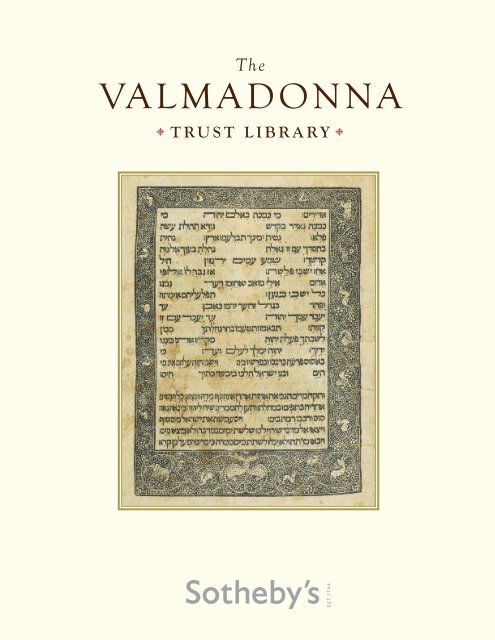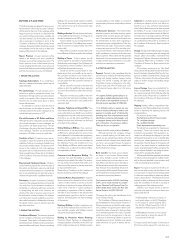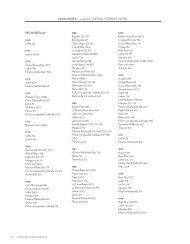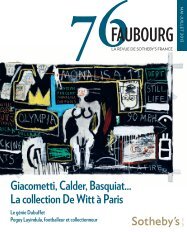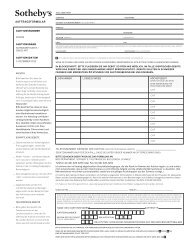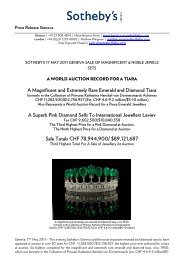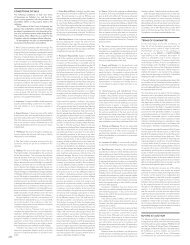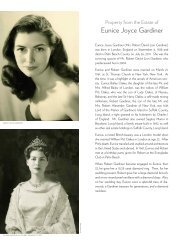Valmadonna Trust Library Brochure - Sotheby's
Valmadonna Trust Library Brochure - Sotheby's
Valmadonna Trust Library Brochure - Sotheby's
You also want an ePaper? Increase the reach of your titles
YUMPU automatically turns print PDFs into web optimized ePapers that Google loves.
The<br />
VALMADONNA<br />
T R U S T L I B R A R Y
The<br />
VALMADONNA<br />
T R U S T L I B R A R Y
Front cover:<br />
The Pentateuch, in<br />
Hebrew and Aramaic.<br />
Híjar, 1490. The third<br />
Spanish edition of<br />
the Pentateuch. Printed<br />
on vellum.<br />
Left: Jack Lunzer,<br />
the Custodian of the<br />
<strong>Valmadonna</strong> <strong>Trust</strong><br />
<strong>Library</strong>.<br />
private or institutional. The product of the far-reach-<br />
ing vision of a single collector, the <strong>Valmadonna</strong> <strong>Trust</strong><br />
remains without equal as the material expression of<br />
a centuries-long cultural heritage whose implications<br />
remain critical to our understanding of the develop-<br />
ment of Western Civilization.<br />
The<br />
VALMADONNA<br />
TRUST LIBRARY<br />
THE VALMADONNA TRUST IS THE FINEST PRIVATE LIBRARY OF<br />
HEBREW BOOKS AND MANUSCRIPTS IN THE WORLD. INDEED, THE<br />
BREADTH AND DEPTH OF THIS UNPARALLELED REPOSITORY OF<br />
RARE MANUSCRIPT AND PRINTED WORKS PLACE IT SQUARELY IN<br />
THE FIRST RANK OF THE GREATEST LIBRARIES OF ITS KIND,<br />
The kernel of the <strong>Valmadonna</strong> <strong>Trust</strong> was planted at<br />
the beginning of the twentieth century but it has<br />
been under the seven-decade custodianship of Jack<br />
Lunzer that the library has flowered into a great<br />
garden of learning, documenting the spread of the<br />
Hebrew press and the dissemination of Jewish<br />
culture around the globe. The treasures of the<br />
<strong>Valmadonna</strong> <strong>Trust</strong> cannot be briefly summarized, but<br />
they include copies of almost half of all extant Hebrew<br />
incunables; the incomparable twelfth-century<br />
English manuscript Pentateuch; arguably the finest<br />
copy in the world of Daniel Bomberg’s edition of the<br />
Babylonian Talmud; and scores of incredibly rare and<br />
even unique sixteenth-century imprints, many being<br />
luxury examples printed on vellum or colored paper.<br />
Perhaps most significant, the size and scope of the<br />
<strong>Valmadonna</strong> <strong>Trust</strong> allow it to illuminate and help explain<br />
subjects, themes, and issues from a myriad of<br />
disciplines outside its area of ostensible specialization.<br />
During the first part of the twentieth century, the<br />
family of Jack Lunzer’s wife had acquired a representative<br />
library of Hebrew books printed in Italy<br />
during the sixteenth century, a period often referred<br />
to as the golden age of Hebrew printing. This cabinet<br />
of splendid Hebrew imprints was acquired by the<br />
<strong>Valmadonna</strong> <strong>Trust</strong> shortly after the end of World<br />
War II, and while Mr. Lunzer has expanded the number<br />
of original volumes many times over (from a few<br />
hundred to nearly 13,000), the aim of the Custodian<br />
was never to simply assemble a large library, but a<br />
great one. Towards that end, Mr. Lunzer has sought<br />
the finest possible copies of books that are not only<br />
rare but truly significant for illustrating and understanding<br />
the Jewish Diaspora.<br />
Because this collecting criteria has been consistently<br />
applied by a single person, every volume in the<br />
library has a reason for being there, from the most<br />
beautifully printed and accurate texts of the illustrious<br />
scholar-printers of the sixteenth century to the rough<br />
and ephemeral pamphlets produced by itinerant job<br />
printers in nineteenth-century Calcutta. Jack Lunzer’s<br />
career may have been spent as a diamond merchant,<br />
but his life’s work was mining far different jewels.
The<br />
EARLIEST<br />
HEBREW PRINTING<br />
UNDOUBTEDLY THE MOST MOMENTOUS TRANSFORMATION THAT<br />
JACK LUNZER EFFECTED IN THE PLAN OF THE LIBRARY WAS THE<br />
EXTENSION OF ITS PERIOD OF INTEREST BOTH FORWARD, TO THE<br />
DAWN OF THE TWENTIETH CENTURY, AND—MORE SIGNIFICANTLY—<br />
REARWARD, TO THE BIRTH OF HEBREW PRINTING AND EARLIER.<br />
Books printed during the fifteenth century have<br />
always been the pride of any great library. And even<br />
though copies of nearly 29,000 incunable editions<br />
survive, fewer than 140 of these are printed in<br />
Hebrew. (The term “incunable” comes from the Latin<br />
for swaddling clothes or cradle and is applied to<br />
books produced during the “infancy” of Western<br />
typographic printing.) Remarkably the <strong>Valmadonna</strong><br />
<strong>Trust</strong> holds copies of nearly half of all Hebrew editions<br />
printed during the incunable period. No other<br />
private library comes close to this level of<br />
comprehensiveness, and only a handful of national<br />
and academic libraries are comparable to it.<br />
Printing was founded in Germany, at the Mainz shop<br />
of Johann Gutenberg in the early 1450s. But because<br />
the German guilds would not admit Jewish apprentices,<br />
Hebrew printing did not begin until the new<br />
technology had spread to Italy. About 1470, shortly<br />
after the Germans Sweynheym and Pannartz established<br />
their press at Rome, Jews were permitted to<br />
work in Italian printing shops and books for the “People<br />
of the Book” were being set in newly cast Hebrew<br />
type. These first Hebrew books share many similarities<br />
with Latin editions printed in Rome at the same<br />
period, and it is likely, as Brad Sabin Hill has<br />
remarked, “that Jews and Christians collaborated in<br />
these early typographic efforts, perhaps even working<br />
in the same shop.” By the year 1500, at least thirty<br />
Hebrew presses had been opened, primarily in Italy<br />
and the Iberian Peninsula.<br />
Although he had acquired a few titles earlier, Jack<br />
Lunzer began the purposeful acquisition of Hebrew<br />
incunables in the 1970s, probably the latest date at<br />
which a significant collection could still be assembled.<br />
The most frequently printed Hebrew incunable texts<br />
were scriptural and legal works, mirroring the predominating<br />
trend among non-Jewish printers of the<br />
period. Secular titles were also published,<br />
including grammars, as well as philosophical, literary,<br />
and medical treatises. The <strong>Valmadonna</strong> <strong>Trust</strong> is rich<br />
in all these categories.<br />
The library contains numerous editions of the<br />
Hebrew Bible or divisions thereof, including the<br />
David Solomon Sassoon copy of the 1490 Híjar<br />
Pentateuch in Hebrew and Aramaic, printed on<br />
vellum, the last dated Hebrew book printed in Spain<br />
before the expulsion of the Jews in 1492. The first<br />
printed editions of Hebrew scripture were actually<br />
preceded off the press by works of Biblical exegesis,<br />
and among its many treasures of early printing, the<br />
<strong>Valmadonna</strong> <strong>Trust</strong> possesses a complete copy of the<br />
only signed imprint from the very first Hebrew printing<br />
shop. This editio princeps of Nahmanides’ commentary<br />
on the Pentateuch, Perush ha-Torah,<br />
contains a proto-colophon announcing that the book<br />
was printed “by the hands of Obadiah and Manasseh<br />
Top: The Pentateuch,<br />
in Hebrew and<br />
Aramaic. Híjar, 1490.<br />
The third Spanish<br />
edition of the<br />
Pentateuch.<br />
Printed on vellum.<br />
Bottom: Mishnah,<br />
with commentary by<br />
Maimonides. Naples,<br />
1492. One of the<br />
first illustrated<br />
Hebrew books.
and Benjamin of Rome.” Although this book is<br />
undated, scholars have deduced that the three were<br />
printing between the years 1469–1473.<br />
Another laurel formerly in the Sassoon collection is<br />
a brilliant copy of the sole complete incunable<br />
edition of the Mishnah—the basic text of rabbinic tradition<br />
and the core of the Talmud—with commentary<br />
by Maimonides. Printed in Naples by Joshua<br />
Solomon Soncino and Joseph ibn Peso, 1492, this<br />
sumptuous edition contains forty-seven woodcut<br />
diagrams including a series of illustrations interpreting<br />
of the rules of eruvin. These simple woodcuts are<br />
among the earliest functional (as opposed to purely<br />
decorative) book illustrations in Hebrew printing.<br />
The <strong>Valmadonna</strong> shelves hold such remarkable legal<br />
incunables as a complete set—four parts bound in<br />
one volume—of the second edition of Jacob ben<br />
Asher’s Arba’ah Turim (Soncino, ca. 1490), a comprehensive<br />
code of Jewish law as well as of customs<br />
and traditions. The title of this of Halakhic compendium<br />
translates as “Four Rows” and alludes to<br />
the jeweled decoration on the breastplate of the<br />
High Priest as well as to the division of the text into<br />
four constituent parts.<br />
The library also houses secular Hebrew texts in relative<br />
abundance. These include Judah ben Jehiel’s<br />
Nofet Zufim, or “Flow of the Honeycomb,” the first<br />
Hebrew book printed during the lifetime of its author.<br />
This humanist text, likely printed in Mantua<br />
about 1475, compares biblical Hebrew rhetoric to the<br />
Greek and Roman classics. The range of the nonscriptural<br />
incunables in the <strong>Valmadonna</strong> <strong>Trust</strong> is surprisingly<br />
wide and encompasses, in addition to<br />
Hebrew texts, Latin books by Jewish authors and<br />
Christian texts of Jewish interest. The subjects of the<br />
secular incunables range from science (Abraham<br />
ben Samuel Zacuto’s Almanach perpetuum<br />
coelestium motuum, Leiria, 1496) to linguistics (David<br />
Kimhi’s Hebrew dictionary, Sefer ha-Shorashim,<br />
Naples, 1490) to travel and exploration (Bernhard<br />
von Breydenbach’s Peregrinatio in terram sanctam,<br />
Speier, 1490) to philosophy (Jedaiah ha-Penini’s<br />
Behinat ha-Olam, Soncino, 1484).<br />
Books, especially Hebrew books, were designed as<br />
utilitarian objects. But Hebrew incunables not only<br />
experienced the repeated reading and study of their<br />
owners (whether individuals or communities), but,<br />
over time, they were also subject to censorship or<br />
mass destruction by Christian authorities. Whole<br />
editions have disappeared, and many books survive<br />
only in unique or highly imperfect copies. A remarkable<br />
proportion of the incunables in the <strong>Valmadonna</strong><br />
<strong>Trust</strong> are complete or near-complete, preserving the<br />
first fruits of Hebrew printing as they were intended<br />
to be read.<br />
Left: The first book<br />
printed in Lisbon,<br />
1489, Nahmanides’<br />
commentary on<br />
Pentateuch, Perush ha-<br />
Torah.<br />
Right: Almanach<br />
perpetuum coelestium<br />
motuum by Abraham<br />
ben Samuel Zacuto.<br />
Leiria, 1496. The first<br />
scientific book (and<br />
first non-religious book<br />
of any kind) printed in<br />
Portugal.<br />
Opposite: Sefer ha-<br />
Shorashim by David<br />
Kimhi. Naples, 1490.<br />
The second edition of<br />
what was probably<br />
the first Hebrew text<br />
ever printed.
A beautifully<br />
illuminated Italian<br />
Hebrew manuscript of<br />
the book of Psalms,<br />
signed by its scribe,<br />
Shemtov ben Samuel<br />
Baruch, in January<br />
1401.<br />
The celebrated<br />
<strong>Valmadonna</strong> English<br />
Pentateuch, written in<br />
1189, and one of the<br />
greatest of all books in<br />
private hands.<br />
MANUSCRIPTS<br />
THE BIBLE, TALMUD, AND OTHER HEBREW TEXTS WERE RECORDED<br />
IN WRITING CENTURIES BEFORE THE EARLIEST PRINTED HEBREW<br />
BOOKS APPEARED IN ROME, AND AMONG THE MANUSCRIPT HOLD-<br />
INGS OF THE VALMADONNA TRUST IS AN EXCEPTIONAL REPOSI-<br />
TORY OF PRECIOUS MEDIEVAL CODICES AND SCROLLS.<br />
The supreme manuscript in the library—and, by con-<br />
sensus, one of the most important privately owned<br />
books in the world—is the Pentateuch written in<br />
England during the first half of 1189. This is the only<br />
extant Hebrew book written in England that can be<br />
dated to before the expulsion of Jews from the British<br />
Isles in 1290; it endures as one of the matchless monuments<br />
of Norman England.<br />
The survival of this manuscript is remarkably fortuitous,<br />
as it was completed by its scribe on the eve of<br />
a tumultuous period in the history of English Jewry.<br />
At the coronation of Richard I in September 1189, a<br />
riot began which resulted in an attack on the Jewish<br />
community of London and the murder of many of its<br />
members. Similar assaults were launched on Jews<br />
throughout England during the following year,<br />
culminating in a massacre at York in spring 1190. A<br />
contemporary chronicler, Ephraim of Bonn, reported<br />
that “The mob which killed the Jews of York then<br />
looted the houses of the slain, took away gold and silver<br />
and the beautiful books they wrote, more precious<br />
than gold … and brought them to Cologne and<br />
to other places, where they sold them to the Jews.”<br />
Ironically, then, the <strong>Valmadonna</strong> English Pentateuch<br />
may have been saved for posterity largely as a result<br />
of its having been plundered.<br />
This earliest dated Anglo-Hebrew manuscript is not,<br />
however, the earliest codex in the <strong>Valmadonna</strong> <strong>Trust</strong><br />
<strong>Library</strong>. Pride of date belongs to a Franco-German<br />
copy of the Pentateuch written in an Ashkenazic<br />
script during the tenth or eleventh century. This book<br />
is one of the earliest texts of the Five Books of Moses<br />
written anywhere in Europe. There are sufficient other<br />
medieval volumes in the library to fill out a goodsized<br />
shelf—including several signed and dated by<br />
their scribes and others richly illuminated with decorative<br />
and figural ornamentation—but the majority of<br />
<strong>Valmadonna</strong>’s three hundred manuscripts are from<br />
the seventeenth through nineteenth centuries. The<br />
manuscripts, ranging from single leaves to multi-volumes,<br />
originate from communities around the globe
Top left:<br />
“Grace After<br />
Meals and other<br />
Benedictions,” a fine<br />
illuminated manuscript<br />
from eighteenth-century<br />
Vienna.<br />
Bottom left:<br />
The earliest manuscript<br />
in the library, a<br />
Franco-German<br />
Pentateuch, probably<br />
written in the tenth or<br />
eleventh century.<br />
Right:<br />
A manuscript Yemenite<br />
Pentateuch from the<br />
early fifteenth century,<br />
with characteristic<br />
Oriental illumination.<br />
and comprise a vast range of content. They provide<br />
an unrivaled first-hand glimpse of the mosaic of<br />
Jewish life and culture during a crucial period of<br />
the Diaspora.<br />
The majority of <strong>Valmadonna</strong> manuscripts derive from<br />
Italy, but others come from Spain, Portugal, France,<br />
Germany, Holland, England, Greece, Yemen, Egypt,<br />
Algeria, Morocco, and India. Virtually all branches of<br />
Jewish literature are represented: Biblical and Talmudic<br />
texts and commentaries, Halakhah and responsa,<br />
prayerbooks (according to the rites of Italy, Provence,<br />
Yemen, Cochin, Corfu, and Algeria among others),<br />
occasional prayers (including, for example, those to<br />
be recited during a cholera epidemic and for deliverance<br />
from drought), poetry, Kabbalah, polemics,<br />
homilies, science, and magic.<br />
Because every manuscript is by definition unique,<br />
every manuscript in the <strong>Valmadonna</strong> library is worthy<br />
of preservation and study: an anonymous gloss on the<br />
Talmud can be just as revealing of the period and<br />
community in which it was written as is a sermon<br />
penned by a historically celebrated rabbi. Still, a few<br />
of the more intriguing eighteenth-century manuscripts<br />
merit individual mention: 32 volumes (of an<br />
original 35) of the autograph manuscript of Rabbi<br />
Isaac Lampronti’s comprehensive Halakhic encyclopedia,<br />
Pahad Yizhak, written in Ferrara; a small decorated<br />
Ashkenazi compendium of “Prayers for<br />
Women”; and a gorgeous Viennese manuscript, 1737,<br />
of “Grace After Meals and other Benedictions,” an archetype<br />
of the eighteenth-century revival of<br />
Hebrew manuscript illumination.
The<br />
“GOLDEN AGE” of<br />
HEBREW PRINTING<br />
THE CRADLE OF HEBREW PRINTING, ITALY REMAINED THE HOME<br />
OF THE MOST PROLIFIC, INNOVATIVE, AND SCHOLARLY HEBREW<br />
PRINTERS THROUGHOUT MOST OF THE SIXTEENTH CENTURY. BUT<br />
HEBREW PRESSES SPREAD EXPONENTIALLY AROUND THE GLOBE AT<br />
THE SAME PERIOD—TO AMSTERDAM, ANTWERP, AND AUGSBURG;<br />
to Berlin, Breslau, and Belgrade; to Cologne,<br />
Cracow, and Constantinople; and even to Africa,<br />
where the Portuguese printer Samuel ben Isaac Ne-<br />
divot established a press at Fez, Morocco. As a result,<br />
the output of Hebrew presses increased nearly<br />
twenty-fold: some 2,700 Hebrew imprints appeared<br />
during the sixteenth century, as opposed to about<br />
140 fifteenth-century editions. And for the first time,<br />
Hebrew works were being printed by (and occa-<br />
sionally for the use of) non-Jews.<br />
Textually and typographically, the Hebrew book<br />
made monumental advances during the sixteenth<br />
century. The <strong>Valmadonna</strong> <strong>Trust</strong> library houses more<br />
than two-thirds of all recorded Hebrew printing from<br />
1501 through 1600, attaining an astonishing comprehensiveness<br />
that rivals its own holding of incunables—and<br />
which, like that collection of earliest<br />
printing, could likely never be assembled again. But<br />
although the field for collecting sixteenth-century<br />
imprints was wider than for incunabula, Jack Lunzer<br />
applied the same exacting criteria of selection—<br />
profound importance and the finest obtainable condition—and<br />
this section of the library contains many<br />
volumes whose price is far above rubies.<br />
The only complete copy<br />
on blue paper of the<br />
Mishneh Torah of<br />
Maimonides, Venice,<br />
1574–1575.<br />
significant numbers of others are either unique<br />
survivals or rare luxury examples printed on vellum<br />
or on colored (especially blue) paper. Indeed,<br />
<strong>Valmadonna</strong>’s collection of approximately 100<br />
sixteenth-century imprints on blue paper eclipses the<br />
holdings of any other library, private or institutional.<br />
Splendid volumes printed on green, yellow, and red<br />
paper (and even on silk) are also scattered along the<br />
<strong>Valmadonna</strong> shelves.<br />
Particularly noteworthy are the collections of books<br />
issued by the itinerant printer Gershom Soncino,<br />
who at Fano revived the Hebrew press after a stillunexplained<br />
hiatus from 1497 to 1503. Soncino<br />
established presses in numerous small communities<br />
of Italy (Fano, Pesaro, Ortona, Rimini, and Cesena),<br />
eventually removing to Salonika and Constantinople.<br />
He produced not just Hebrew books, but also<br />
humanist texts in Latin, of which the library also has<br />
a remarkable range.<br />
ITALY<br />
THE VALMADONNA TRUST INCLUDES VIRTUALLY COMPLETE<br />
HOLDINGS OF THE WORK OF THE HEBREW PRINTERS OF MANTUA,<br />
VENICE, FERRARA, CREMONA, PISA, VERONA, LIVORNO, AND TRI-<br />
ESTE. SUBJECT TO CONFISCATION AND CENSORSHIP, MANY OF<br />
THESE EARLY BOOKS ARE RECORDED IN ONLY A FEW COPIES;<br />
Not only is every Italian town with a Hebrew press<br />
represented in the <strong>Valmadonna</strong> <strong>Trust</strong> library, but<br />
virtually all are distinguished by at least one tremendous<br />
rarity. For instance, Genoa can claim one of the<br />
few vellum copies of Porro’s celebrated 1516 edition<br />
of the Psalms in five languages, the most ambitious<br />
linguistic work published to that time and the first<br />
polyglot text ever printed. Bologna can boast a<br />
vellum copy, with gilt-lettered headings, of the<br />
Roman rite Siddur printed by Talmi in 1537 for the<br />
famous Bolognese guild of silk-weavers. The<br />
imprints from Mantua include a blue-paper copy of<br />
Samuel Zarza’s commentary of the Pentateuch,<br />
Mekor Hayim, printed in 1559. And just as Venice<br />
was the largest center of Hebrew printing in Italy, the<br />
<strong>Valmadonna</strong> collection is also preeminent in Venetian<br />
imprints, particularly the works produced by<br />
Daniel Bomberg, Marco Antonio Giustiniani, and<br />
the Bragadin family.
The<br />
BOMBERG TALMUD
The<br />
BOMBERG TALMUD<br />
DANIEL BOMBERG IS RESPONSIBLE FOR PRINTING THE FIRST<br />
COMPLETE EDITION OF THE BABYLONIAN TALMUD (1519/20-1523),<br />
UNIVERSALLY RECOGNIZED NOT SIMPLY AS ONE OF THE MOST<br />
SIGNIFICANT BOOKS IN THE HISTORY OF HEBREW PRINTING, BUT<br />
AS ONE OF THE GREAT BOOKS OF THE WESTERN WORLD.<br />
A native of Antwerp, Bomberg established his own<br />
printing shop in Venice in 1516. The first Christian<br />
printer of Hebraica, Bomberg<br />
produced a corpus of nearly<br />
two hundred basic texts of Judaism,<br />
many of which had<br />
never before been printed. Like<br />
the other great scholar-printers<br />
of the sixteenth-century, notably<br />
the family Estienne,<br />
Bomberg became known for<br />
texts that were scrupulously accurate<br />
and beautifully produced.<br />
To ensure precision,<br />
Bomberg hired Jewish typesetters<br />
and proofreaders. He<br />
also went to great expense in<br />
casting several sizes of Hebrew<br />
type, and Bomberg’s fonts<br />
were so esteemed that they<br />
continued to be used by other<br />
printers (typically identified as<br />
“Bomberg type”) long after his<br />
own printing career ceased in<br />
1549. Indeed, it is principally<br />
due to the enduring legacy of<br />
Daniel Bomberg that Venice<br />
remained the center of Hebrew printing until well<br />
into the eighteenth century.<br />
While the Hebrew Bible is undoubtedly the foundation<br />
upon which Judaism is built, it is the Talmud that<br />
serves as the framework that has given form to Jewish<br />
life and ritual observance across the centuries.<br />
While the books of the Hebrew<br />
Bible are referred to as the “Written<br />
Law,” signifying their fixed<br />
position within the canon, the<br />
Talmud is an integral part of the<br />
“Oral Law,” a body of knowledge<br />
whose basic tenets are believed<br />
to have been transmitted to<br />
Moses at Sinai as a necessary<br />
and complementary corollary to<br />
the “Written Law” of the Hebrew<br />
Bible.<br />
Compiled by Jewish scholars in<br />
the fifth century CE, the Talmud<br />
was transmitted orally, with written<br />
manuscripts first appearing<br />
during the Middle Ages. The dissemination<br />
of these manuscripts<br />
continued until the rise of printing<br />
in the fifteenth century. Beginning<br />
with the Soncino press in<br />
1483, Hebrew printers interwove<br />
the ancient rabbinic texts with the<br />
words of later commentators,<br />
and the Talmud page began to take on the complex,<br />
layered format that is now familiar to modern readers.<br />
A few individual tractates of the Talmud had been<br />
printed previously, but Bomberg was the first printer<br />
to take on the daunting task of issuing all sixty-three<br />
Previous page: The<br />
Westminster Abbey-<br />
<strong>Valmadonna</strong> set of the<br />
Bomberg Talmud.<br />
Left: Detail of the<br />
original Oxford binding<br />
of one of the Talmud<br />
volumes, showing the<br />
initials of the first<br />
owner, Richard<br />
Brauarne, stamped in<br />
the center.<br />
Right: A characteristic<br />
page-opening<br />
illustrating the exquisite<br />
layout of the Bomberg<br />
Talmud.<br />
standard tractates. The format of Bomberg’s first<br />
complete edition of the Talmud remains the model<br />
for all subsequent editions to the present day.<br />
Bomberg’s pagination is still followed, as is his<br />
arrangement of the commentary: that of the<br />
eleventh-century French scholar Solomon ben Isaac<br />
(also known by his acronym, Rashi) appearing in the<br />
inner margin, and the collected and distilled discussion<br />
of Rashi’s students, the Tosafot, in the outer margins.<br />
Bomberg also printed, 1523–1524, the first<br />
complete Jerusalem Talmud, two copies of which are<br />
in the <strong>Valmadonna</strong> library. Both the Babylonian and<br />
Jerusalem editions of the Talmud were undertaken<br />
with the approbation of the Venetian Senate and<br />
Pope Leo X.<br />
In 1956, the Custodian of the <strong>Valmadonna</strong> <strong>Trust</strong> attended<br />
an exhibition at the Victoria and Albert Museum<br />
celebrating 300 years of Jewish resettlement<br />
in England. There, he first became aware of Westminster<br />
Abbey’s magnificent complete copy of the<br />
Talmud and spent close to 25 years courting the<br />
Westminster Abbey in an attempt to acquire it.<br />
Eventually, he purchased a 900-year old copy of the<br />
Abbey’s original Charter and presented it, along with<br />
supporting endowments, to the Abbey in exchange<br />
for its copy of the Bomberg Talmud.<br />
The amazingly fresh condition of the nine-volume<br />
<strong>Valmadonna</strong> Talmud is complemented by its distinguished<br />
provenance and magnificent contemporary<br />
binding. The <strong>Valmadonna</strong> copy is bound in blindpanelled<br />
calf incorporating the central cipher of<br />
Richard Bruarne, Regius Professor of Hebrew at Oxford<br />
from 1546 to 1556. After Bruarne’s death, the<br />
Talmud eventually passed to Westminster Abbey, in<br />
whose library it resided practically undisturbed for<br />
four centuries. In terms of importance, rarity, and<br />
condition, the <strong>Valmadonna</strong> copy of Daniel<br />
Bomberg’s Babylonian Talmud is virtually without<br />
peer. If the first half of the sixteenth century is the<br />
“Golden Age” of Hebrew printing, then the<br />
Bomberg Talmud is undoubtedly the pinnacle<br />
achievement of the period.
Top left: One of just<br />
two surviving copies of<br />
the 1556 Prague<br />
Haggadah.<br />
Bottom left: Title-page<br />
of the 1526 Prague<br />
Haggadah, printed on<br />
vellum.<br />
Right: The illustrations<br />
in this 1695<br />
Amsterdam edition of<br />
the Haggadah<br />
established a new<br />
iconography that would<br />
endure in Hebrew<br />
books for centuries.<br />
NORTHERN,<br />
CENTRAL &<br />
EASTERN EUROPE<br />
HEBREW PRINTING NORTH OF THE ALPS BEGAN IN PRAGUE IN 1512<br />
WITH THE CIRCLE OF GERSHOM BEN SOLOMON KOHEN. PRAGUE<br />
WAS SOON ESTABLISHED AS A GREAT HUB OF LITURGICAL HEBREW<br />
PRINTING, AND FROM THERE THE PRESS MIGRATED TO CRACOW<br />
AND LUBLIN.<br />
Two of the <strong>Valmadonna</strong> <strong>Library</strong>’s greatest vellum<br />
books were printed in Prague. The first is an<br />
extraordinary copy of the Haggadah shel Pesah,<br />
printed in 1526 by Gerhsom Kohen and his brother<br />
Grunim; this is the earliest dated and illustrated edition<br />
of the Haggadah, and contains, as a table-song,<br />
the first printed verse in Yiddish. The second vellum<br />
treasure is also a Haggadah, published in 1556 by the<br />
grandsons of the printer of the earlier edition. This<br />
was the first Haggadah to be directed at a large,<br />
popular audience. Ironically, though, due to heavy<br />
demand and the fire that ravaged the Prague Jewish<br />
ghetto in 1557, only one other copy of this edition<br />
is known to exist, in the British <strong>Library</strong>.<br />
The Hebrew press spread to Oels, Augsburg, and<br />
other smaller towns. As Christian scholars such as<br />
Joannes Reuchlin and Sebastian Muenster became<br />
interested in Hebrew, scholar-printers like Estienne<br />
in Paris, Froben in Basel, and Plantin in Antwerp supplied<br />
their needs. The <strong>Valmadonna</strong> <strong>Library</strong> contains<br />
Christian Hebraica from university towns like Hagenau,<br />
Cologne, Tuebingen, a unique copy of Plantin’s<br />
Biblia Hebraica (Antwerp, 1584) printed on green<br />
paper, and the Chatsworth copy of the Complutensian<br />
Polyglot Bible (Alcala de Henares, 1514–1517).<br />
Rare eighteenth-century vellum imprints of liturgical<br />
texts from Sulzbach and Wilhermsdorf accompany<br />
numerous examples from the major printing<br />
cities of Basel, Paris, Cracow, Prague, and Geneva.<br />
Seventeenth- and eighteenth-century Hebrew printing<br />
in Amsterdam includes a nearly complete collection<br />
of the works of Manasseh ben Israel, and a<br />
wide selection of Spanish and Portuguese liturgies<br />
with several printed on vellum.
The<br />
OTTOMAN EMPIRE<br />
EXPELLED FROM SPAIN AND PORTUGAL IN 1492 AND 1497, JEWS<br />
FOUND SAFE HAVENS IN THE OTTOMAN EMPIRE CITIES OF<br />
CONSTANTINOPLE AND SALONIKA AS WELL AS IN FEZ, MOROCCO.<br />
ALMOST IMMEDIATELY AFTER THEIR SETTLEMENT IN THESE<br />
REGIONS, SEPHARDIC JEWS ESTABLISHED PRINTING PRESSES USING<br />
Hebrew type. The first books printed outside Europe<br />
were produced on Jewish presses.<br />
The <strong>Valmadonna</strong> <strong>Trust</strong> <strong>Library</strong>’s thorough collection<br />
of Ottoman Empire imprints contains over 350<br />
books printed at Constantinople, including the very<br />
first book printed in Turkey—Jacob ben Asher’s<br />
Arba’ah Turim, printed in 1493 by David and Samuel<br />
ibn Nahmias, exiles from Spain. The <strong>Library</strong> also<br />
maintains a first edition of the first secular book to<br />
be printed at Constantinople: Ben ha-Melekh ve-ha-<br />
Nazir (The Prince and the Hermit), an adaptation of<br />
an Arabic philosophical romance long popular in<br />
Hebrew manuscript.<br />
Another remarkable acquisition made by the Custodian,<br />
from the legendary collection of Salman<br />
Schocken, is the first book printed in any language<br />
on the African continent, the Sefer Abudarham, published<br />
by the Portuguese printers Samuel ben Isaac<br />
Nedivot and his son Isaac in 1516 and based on an<br />
edition of the work produced at Lisbon 27 years earlier.<br />
Additionally, the <strong>Library</strong> comprises about 440<br />
volumes produced in shops in Salonika.<br />
One of the most intriguing books from this portion<br />
of the library is a contemporary “Sammelband” (or,<br />
collected volume) of five different works published in<br />
Constantinople during the second decade of the<br />
sixteenth-century. These works were purchased by<br />
a single reader, who then had them bound together<br />
for easy consultation: Jacob ben Asher’s Perush<br />
ha-Torah (1514); Halikhot Olam (1510); Avodat ha-<br />
Levi (1510); Ottiyot shel Rabbi Akiva (1520); and Alfa<br />
Beta d’Ben Sira (1519).<br />
Left: Teshuvot ha-Rav.<br />
Constantinople, 1546-<br />
1547. These responsa<br />
of Isaac ben Sheshet are<br />
a vital source for the<br />
social history of Jews in<br />
medieval Spain and<br />
North Africa.<br />
Right:Perush ha-Torah<br />
by Jacob ben Asher,<br />
Constantinople, 1514.<br />
Bound first in a<br />
contemporary<br />
Sammelband of five<br />
imprints.
Left: “Menorah,” a<br />
Calcutta lithograph<br />
printed in gold ink on<br />
red paper at the end of<br />
the nineteenth century.<br />
Such blessing sheets<br />
were given to students<br />
by teachers as a reward<br />
at Hannukah time.<br />
Right: This trilingual<br />
broadside, printed in<br />
Bombay in 1896,<br />
commemorates the<br />
centenary of the<br />
synagogue Sha’ar ha-<br />
Rahamim in Hebrew,<br />
English and Marathi,<br />
the vernacular of<br />
Bombay.<br />
INDIA &<br />
THE FAR EAST<br />
PERHAPS THE MOST SURPRISING—AND ONE OF THE RICHEST—AREAS<br />
OF THE VALMADONNA TRUST LIBRARY IS ITS ASTONISHING COLLEC-<br />
TION OF HEBREW PRINTING FROM INDIA AND THE FAR EAST. COM-<br />
POSED LARGELY OF PAMPHLETS AND OTHER EPHEMERAL IMPRINTS,<br />
including periodicals, these holdings represent one<br />
of the Custodian’s greatest collecting achievements.<br />
Judaism was among the first non-Dharmic religions<br />
recorded in India, with both the Cochin Jews and the<br />
Bene Israel Jews settling, respectively, in Kerala and<br />
Maharashta (later Bombay) during the early Middle<br />
Ages. The first Hebrew presses were established in<br />
Calcutta and Bombay in 1840-1841. By the end of<br />
the nineteenth century, additional Hebrew presses<br />
at Poona and Cochin produced books notable for<br />
their linguistic variety and graphics. The Indian imprints<br />
of the <strong>Valmadonna</strong> <strong>Library</strong> are unequalled<br />
both in their number and their quality–no public<br />
institution holds so comprehensive a collection. The<br />
<strong>Valmadonna</strong> <strong>Trust</strong> also includes a small but significant<br />
number of Hebrew imprints from China,<br />
particularly Shanghai, including a very scarce run of<br />
The Israel Messenger.<br />
The Hebrew press in Baghdad was one of the last<br />
Hebrew presses established in Western Asia. At the<br />
end of the 1860s, movable Hebrew type was<br />
introduced there by a printer trained in Bombay,<br />
transforming Baghdad into one of the prolific centers<br />
of Hebrew printing in the Orient. The presence<br />
of over 500 books and pamphlets printed in Baghdad<br />
in Hebrew, Judeo-Arabic, and Aramaic, makes<br />
the <strong>Valmadonna</strong> <strong>Trust</strong> <strong>Library</strong> one of the world’s vital<br />
resources for the study of Asian Hebraica.
WALL CALENDARS<br />
& BROADSHEETS<br />
IN ADDITION TO INCUNABLES AND MANUSCRIPTS, THE VALMADONNA<br />
TRUST ENCOMPASSES A THIRD COLLECTION OF OBJECTS THAT<br />
SHOULD BE STUDIED AS A WHOLE, RATHER THAN SEPARATED BY<br />
PERIOD AND PLACE OF ORIGIN: WALL CALENDARS AND<br />
BROADSHEETS OF ALL MANNER SPANNING THE SIXTEENTH TO THE<br />
NINETEENTH CENTURIES.<br />
Of special interest are the sixteenth- and seven-<br />
teenth-century Italian wall calendars. Originating<br />
largely from Mantua, Venice, and Sabbioneta, these<br />
calendars and almanacs provide invaluable insight<br />
into the popular beliefs and quotidian life of the<br />
Jewish communities they served.<br />
The general broadsides cover a much wider field of<br />
subject matter and come from presses around the<br />
globe, including India and Jerusalem. Noteworthy<br />
are the many celebratory wedding poems and<br />
riddles from Italy, usually ornamented with several<br />
woodcut illustrations. Others broadsides present<br />
occasional poems and prayers, elegies, hymns,<br />
polemics, liturgical texts, educational instruction, and<br />
rules and regulations to be observed in various<br />
communities. Of course, the wall calendars and<br />
broadsheets alike were ephemeral publications, and<br />
so their survival rates are very low; many of the<br />
<strong>Valmadonna</strong> <strong>Trust</strong>’s nearly 600 examples are unique<br />
copies. This is especially true regarding polemical<br />
broadsheets, since attempts were often made to<br />
destroy all known copies.<br />
Left: An early Hebrew<br />
alphabet chart, printed<br />
in Frankfurt about<br />
1650 and intended as a<br />
teaching tool for<br />
children learning the<br />
holy tongue.<br />
Right: Broadside<br />
wedding poem<br />
celebrating the nuptials<br />
of Rebecca, daughter of<br />
Sabbetai Isaac Ambron<br />
and Solomon Judah,<br />
son of Gabriel<br />
Ambron. Printed on<br />
blue paper in Livorno,<br />
1792.<br />
Following page: First<br />
printing of the Biblia<br />
Rabbinica, and the first<br />
great production of<br />
Daniel Bomberg’s<br />
Venetian press, 1516-<br />
1517. The<br />
<strong>Valmadonna</strong> copy is<br />
one of a very few<br />
Renaissance Hebrew<br />
printed books with<br />
illumination.<br />
Rear cover:<br />
The contemporary<br />
Oxford binding of the<br />
<strong>Valmadonna</strong> set of the<br />
Bomberg Talmud.
The <strong>Valmadonna</strong> <strong>Trust</strong> <strong>Library</strong> has long been open to scholars and other readers with an interest in<br />
perusing its books and manuscripts. Many of its great treasures have been loaned to exhibitions around the<br />
world, and the <strong>Trust</strong> has published catalogues of its holdings, as well as facsimile editions of works<br />
that exist nowhere else. But the Sotheby’s exhibition that this brochure commemorates is the very first time<br />
that the <strong>Valmadonna</strong> <strong>Trust</strong> <strong>Library</strong> has been on view in its entirety.<br />
For more information about the <strong>Library</strong>, contact David Redden, Vice Chairman, Sotheby’s, at +1 212 606 7386.
1334 YORK AVENUE NEW YORK NY10021 I 212 606 7000 I SOTHEBYS.COM


